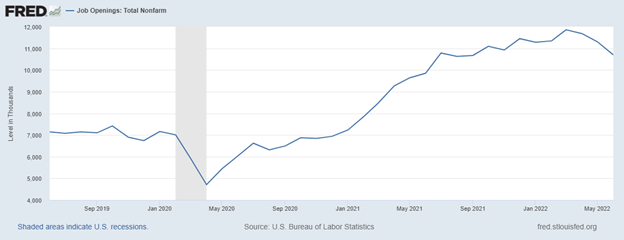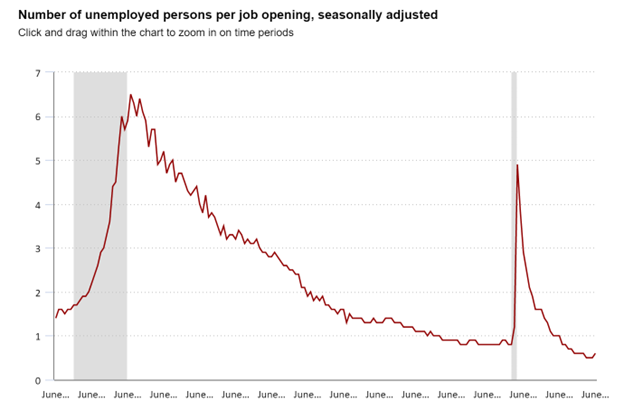Image Credit: Brenda Gottsabend
Labor Market Statistics are Pointing to Lower Wage Inflation
The job market may be returning to normalcy; this is a good sign for lower inflation. The
JOLTS report, which is released by The Labor Department, is similar to a supply chain measure for how adequate the economy’s labor and jobs match up. It tracks monthly changes in job openings and job offer rates on hiring and also quits. Overall, the movement toward what was considered normal and even desirable before the pandemic has accelerated. JOLTS is an acronym for Job Openings and Labor Turnover Survey.
The Numbers
Job openings fell to 10.7 million from 11.3 million in June, according to the data released Tuesday (August 2). The median estimate from economists was 11 million, which means jobs fell short of expectations. It was the largest one-month drop since the pandemic. This gives hope that shortages of labor have decreased.
Largest among the drop are positions in retail. Retailers accounted for more than half of the decline in openings. The sector shed 343,000 openings in June. Wholesalers followed with the next largest drop of 82,000 openings. Public education was third, with openings reduced to 62,000.
The industry seeing the most gains in job listings was the finance and insurance category; this sector added 31,000 openings. And while positions in public education were down, positions in educational services increased by 22,000 openings.

Source: St.
Louis Federal Reserve
The number of unemployed Americans per job opening climbed to 0.6 in June from 0.5. This added to signs that the labor market is normalizing. However, 0.6 people for every 1.0 position is still a challenging mismatch for employers. However, it is the first move toward having at ample people looking, even if they may not be an adequate fit for each role. The JOLTS report had a three-month streak of record-low workers-per-openings ratios. This is good for employers and helps taper wage pressures.

Source: US
Bureau of Labor Statistics
There is still plenty of room for further movement toward normalcy. Labor force participation, that is, the percentage of Americans either working or actively seeking work, dropped in June to 62.2%. Pre-pandemic, the participation rate was 63.4%.
Resignations or quits data also point to the labor market’s imbalance moving towards normal. The total quits in June dropped to 4.2 million from 4.3 million. This is the lowest level since October. Quits have now fallen for three straight months straight after breaking records last year.
Take Away
When labor markets are not tight, wage earners are less likely to require higher wages to stay. One of the factors contributing to the year-long inflation spike in the U.S. is a shortage of labor. The lower number of job openings and reduced quit rates now suggest the supply and demand of workers may be moving toward better alignment.
A healthy economy requires willing and suitable workers and adequate positions for those workers. June was a good sign that this is beginning to occur.
Managing Editor, Channelchek
Suggested Content
 Will the Markets Continue to Build through August?
|
 A Small Cap Leading Indicator on Whether or Not We’re in a Recession
|
 What Might be in a Portfolio Allocated for a Republican Majority in the House?
|
 Senate Marijuana Bill Expected Before Summer Break
|
Stay up to date. Follow us:

|
